Tom's Hardware Verdict
The Asus ROG Strix XG248QSG Ace is currently the fastest monitor you can buy. But those frame rate bragging rights will cost as much as a premium OLED. If 500 or 600fps is your goal, it’s the only game in town.
Pros
- +
Solid contrast with zone dimming feature
- +
Very colorful with best-in-class HDR
- +
Incredible frame rates with low input lag
- +
Superb video processing with effective blur reduction
- +
Accurate color out of the box
- +
Premium build quality
Cons
- -
No smoother than most 240 Hz OLEDs
- -
Expensive
Why you can trust Tom's Hardware
Will there ever be a time when the best gaming monitors reach their maximum speed? Is there an as-yet unknown limit on frame rates? If you subscribe to Moore’s Law, you know that for decades, integrated circuits doubled their transistor density about every two years. However, this progress has slowed due to the inevitable physical limitations that arise from creating components not much larger than a molecule. You can only get so small.
Monitors have a ways to go, apparently, because fresh on the heels of my first 500 Hz OLED review, I’ve just cracked open the box to Asus’ latest screamer: the ROG Strix XG248QSG Ace. This 24-inch TN 1080p screen operates at 600 Hz and overclocks to 610 Hz, while also offering Adaptive-Sync and two types of blur reduction. You also get HDR10, accurate wide-gamut color, and brightness over 400 nits. Let’s take a look.
Asus ROG Strix XG248QSG Ace Specs
Panel Type / Backlight | TN / W-LED, edge array |
| Row 1 - Cell 0 | 8 horizontal dimming zones |
Screen Size / Aspect Ratio | 24 inches / 16:9 |
Max Resolution and Refresh Rate | 1920x10800 @ 600 Hz |
| Row 4 - Cell 0 | 610 Hz w/overclock |
| Row 5 - Cell 0 | FreeSync and G-Sync Compatible |
Native Color Depth and Gamut | 8-bit / DCI-P3 |
| Row 7 - Cell 0 | HDR10, DisplayHDR 400 |
Response Time (GTG) | 0.08ms |
Brightness (mfr) | 400 nits |
Contrast (mfr) | 1,000:1 |
Speakers | None |
Video Inputs | 1x DisplayPort 1.4 |
| Row 13 - Cell 0 | 2x HDMI 2.1 |
Audio | 3.5mm headphone output |
USB | None |
Power Consumption | 33w, brightness @ 200 nits |
Panel Dimensions WxHxD w/base | 21.9 x 13.9-20.2 x 7.4 inches (556 x 353-513 x 188mm) |
Panel Thickness | 3.4 inches (86mm) |
Bezel Width | Top/sides: 0.4 inch (10mm) |
| Row 20 - Cell 0 | Bottom: 0.7 inch (19mm) |
Weight | 12.4 pounds (5.6kg) |
Warranty | 3 years |
The XG248QSG Ace is an esports tool, much like a race car with just enough bells and whistles to be a formidable gaming screen, but without any features that would reduce frame rates, such as excessive resolution. Although many gamers are gravitating towards QHD and UHD screens due to their high pixel density, FHD remains the choice for maximum frame rates. It also utilizes a TN part, which is widely regarded as the most responsive panel technology among LCDs.
Although the pixel density is relatively low at 92ppi, there are some effective picture enhancements, including HDR10 support, wide gamut color, and high brightness. Backlight zone dimming (eight horizontal zones) is also available for HDR and SDR, which, in some cases, increases contrast past the point of measurability. Speaking of that backlight, Asus has upped its game with ELMB (Extreme Low Motion Blur), its form of backlight strobing, AKA black frame insertion. You get ELMB Sync, which works along with Adaptive-Sync to remove blur and prevent frame tears. Alternatively, you can opt for ELMB 2 instead of AS, which offers five levels of pulse width modulation.
Although you sacrifice some off-axis image quality with the TN panel, it remains a bright and colorful screen. The gamut covers around 92% of DCI-P3, which is more than most in the super-fast esports class. Most FHD screens with a refresh rate over 360 Hz are sRGB+ at best. You also get a bright backlight, which peaks at nearly 450 nits for SDR and over 525 nits in HDR mode. The XG248QSG is DisplayHDR 400 certified.
Asus includes its full suite of GamePlus aids, which feature aiming points, sniper mode, timer, stopwatch, multiple frame counters, and alignment marks. You can plug headphones into a 3.5mm jack, but there are no USB ports or internal speakers here. Video inputs include two HDMI 2.1 and a DisplayPort 1.4 with Display Stream Compression (DSC). Slick styling and premium build quality are also included.
So, are there downsides? The price might be an obstacle for some. At the time of writing, the XG248QSG is priced at $1,000. To be fair, it has no exact equal at present. However, one could also purchase a 500 Hz OLED from Asus, the XG27AQDPG, which features QHD resolution and a 27-inch screen with Quantum Dot color, for around the same price. If you’re wondering how the two monitors compare, I’ve included said OLED in my charts so you can see for yourself.
Get Tom's Hardware's best news and in-depth reviews, straight to your inbox.
Assembly and Accessories
My XG248QSG arrived with the upright already attached; I just had to put on the small but heavy metal base with a captive bolt. The package is very solid and free of any wobble or play. The zippered pouch that ships with nearly all Asus gaming monitors contains just a DisplayPort cable and a small external power supply. There isn’t much there, but you don’t need more than that to get playing.
Product 360
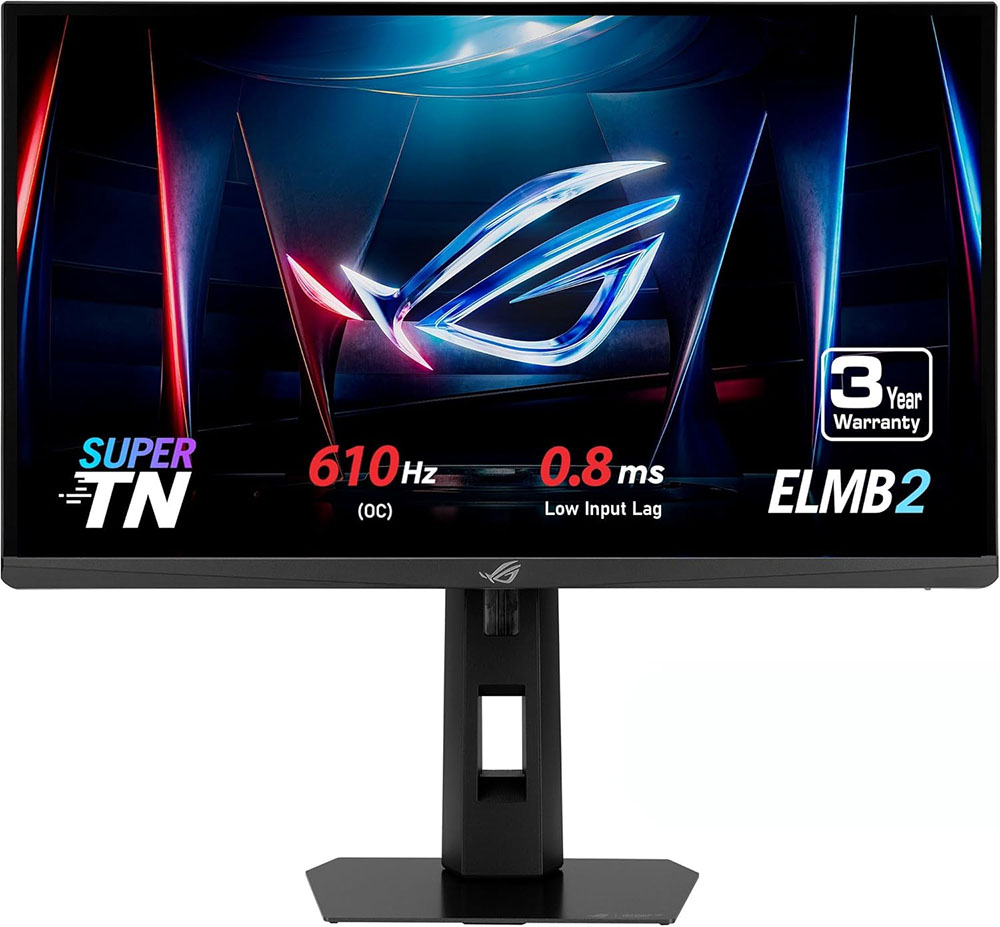
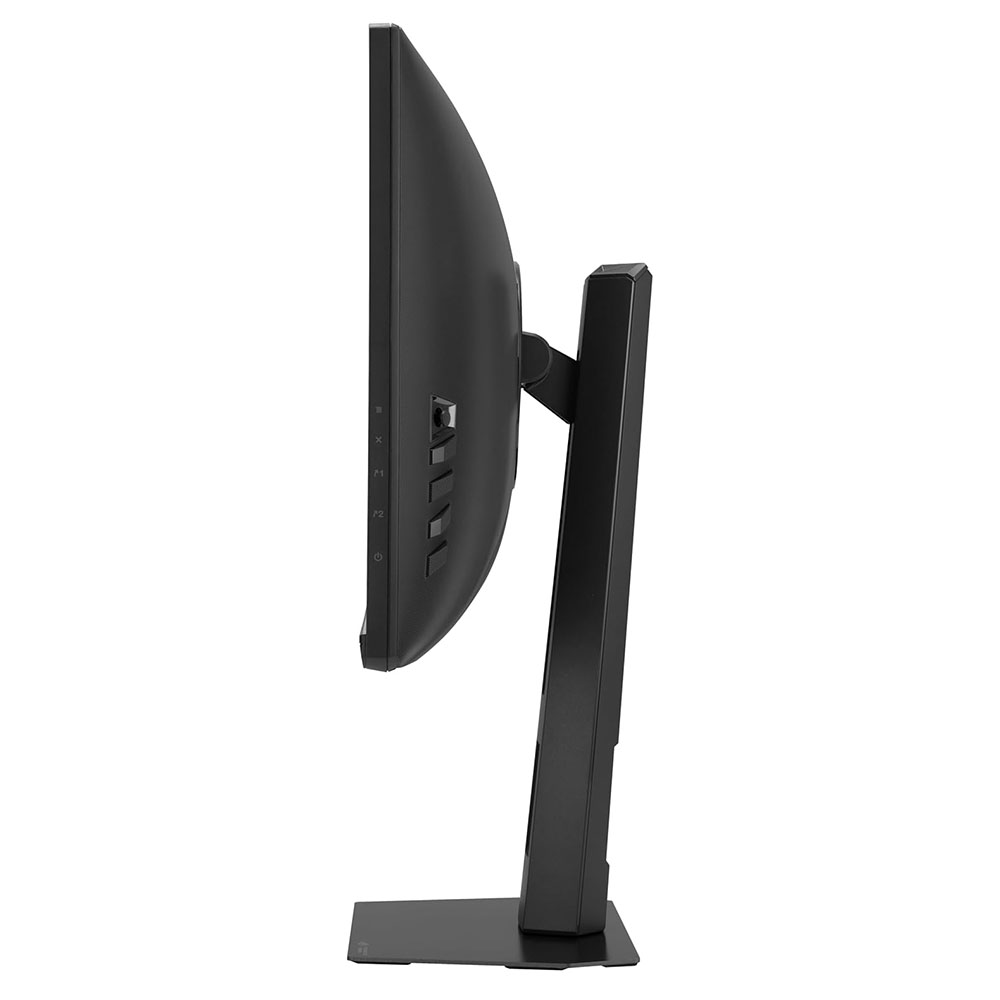
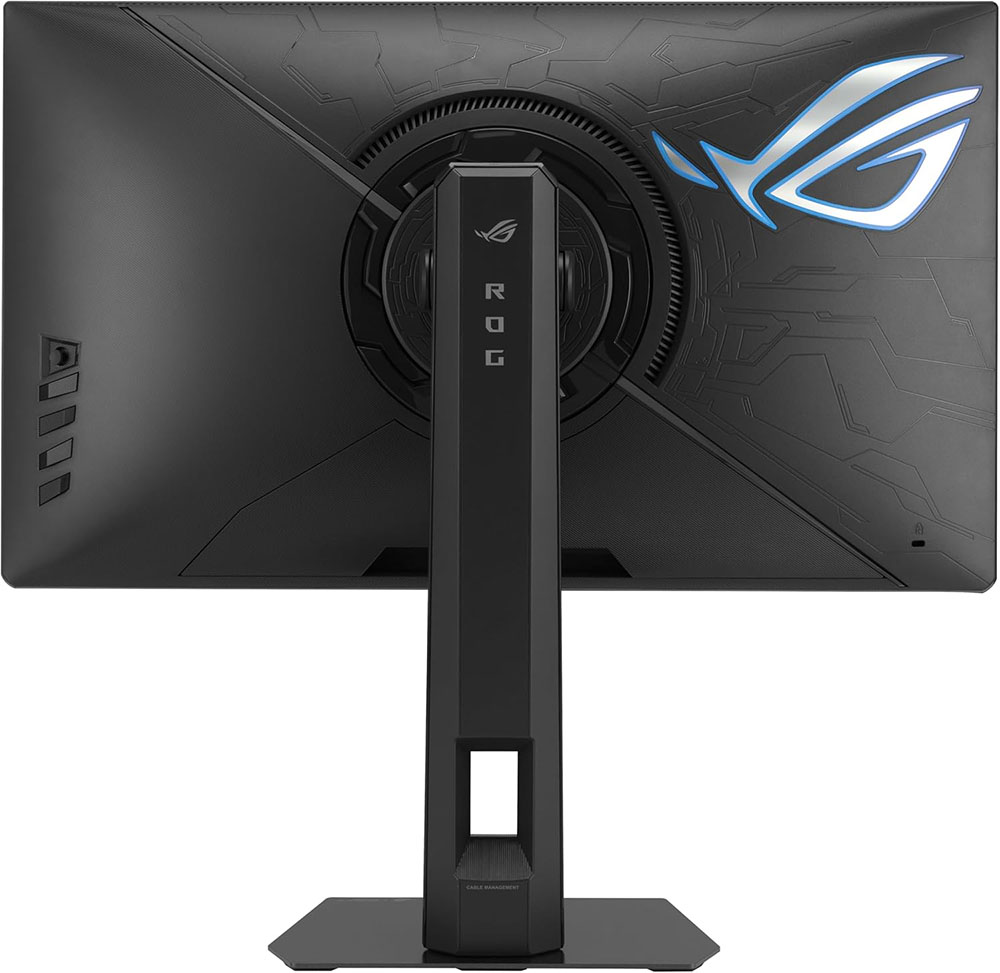
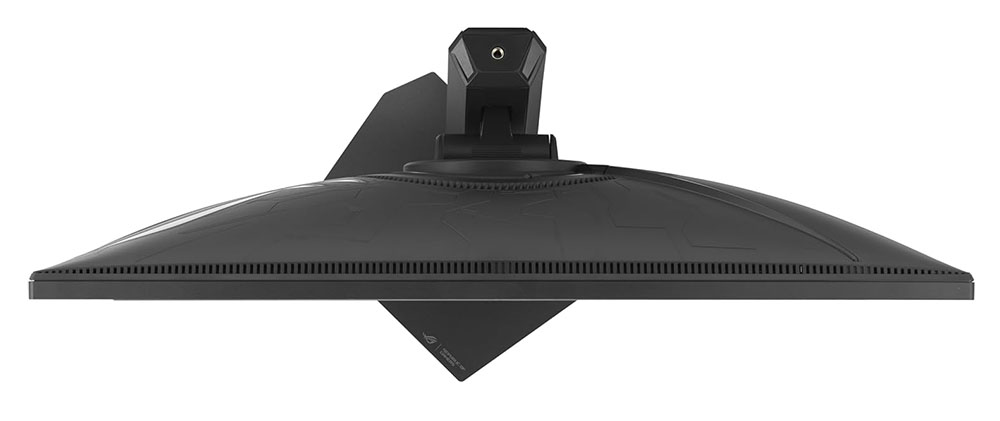
The XG248QSG is a full 24 inches diagonal, 24.1 inches to be exact, not 23.5 or 23.8 like most 24-inchers. With a thin bezel, it nearly pulls off the border-free look. A small ROG logo is the only thing you see up front besides the image. The control keys and joystick are around the back right. They’re large and easy to operate by feel.
The stand is rock solid despite its small base, which is designed to minimize the XG248QSG’s footprint. However, it doesn’t compromise stability. The monitor ain’t goin’ anywhere, even when you might be pounding on the keyboard during intense gameplay. The back of the panel is smoothly tapered from edge to edge and features molded lines that resemble the surface of the Death Star. There are also LEDs back here, in the form of a backlit ROG logo that features multiple colors and effects through Aura Sync and Aura RGB. All of this can be controlled in the OSD or with Asus’ DisplayWidget Center app.
The stand has full ergonomics with 5/35 degrees tilt, 45 degrees swivel, 6.3 inches height, and a 90-degree portrait mode. Movements befit a premium display with firm positioning and no play or slop. The stand also features a quarter-inch threaded socket at the top for items such as webcams and desk lights.
The input panel is very recessed, up and under, so much so that I had trouble plugging in my fat-ended cables. There are two HDMI 2.1 ports and a DisplayPort 1.4 with DSC. You also get a 3.5mm headphone jack. There are no USB ports or internal speakers.
OSD Features
The XG248QSG’s OSD appears when you press the joystick, or you can use the three control keys to call up often-used functions. The menu is classic Asus ROG with a logical layout and a full set of gaming and image adjustment options.
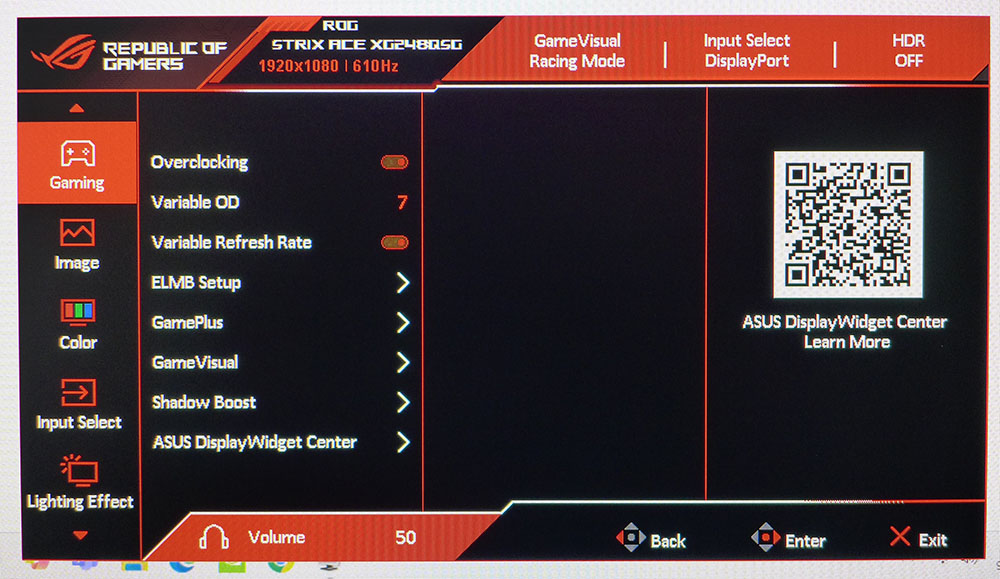
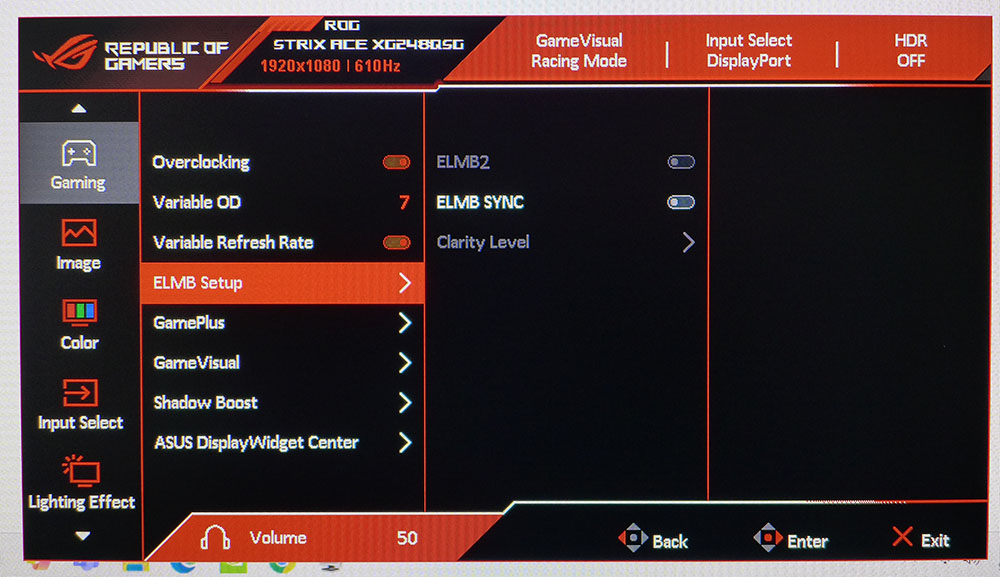
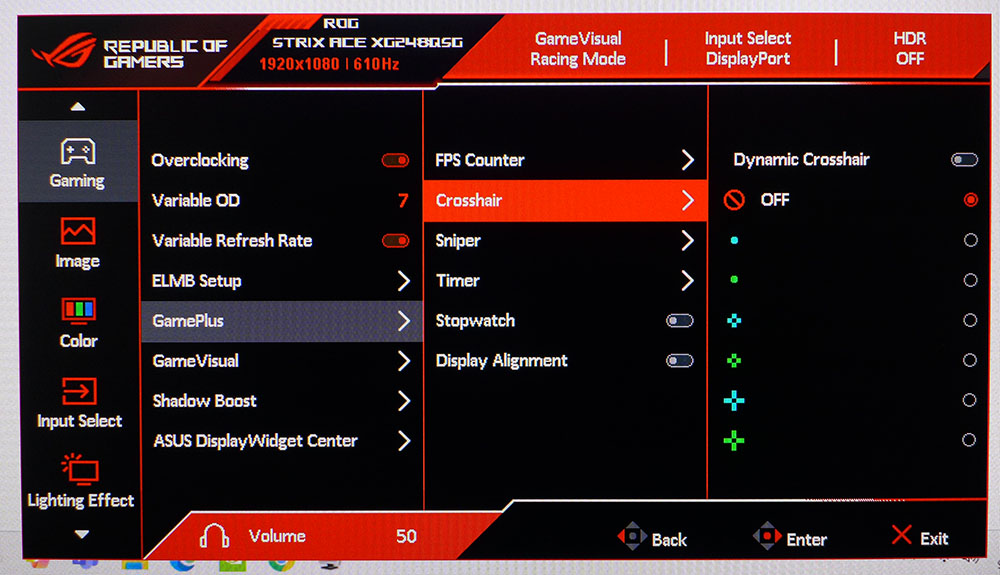
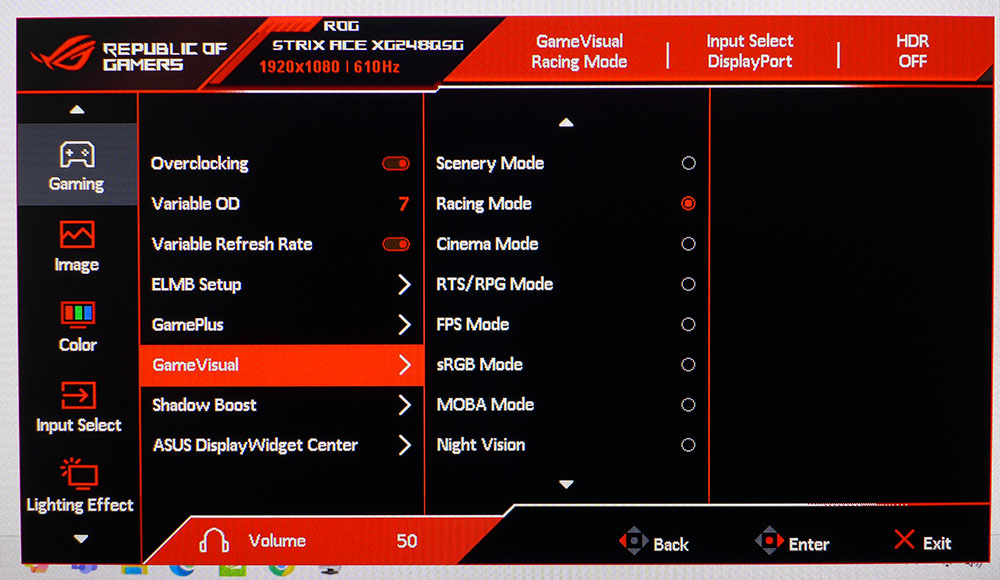
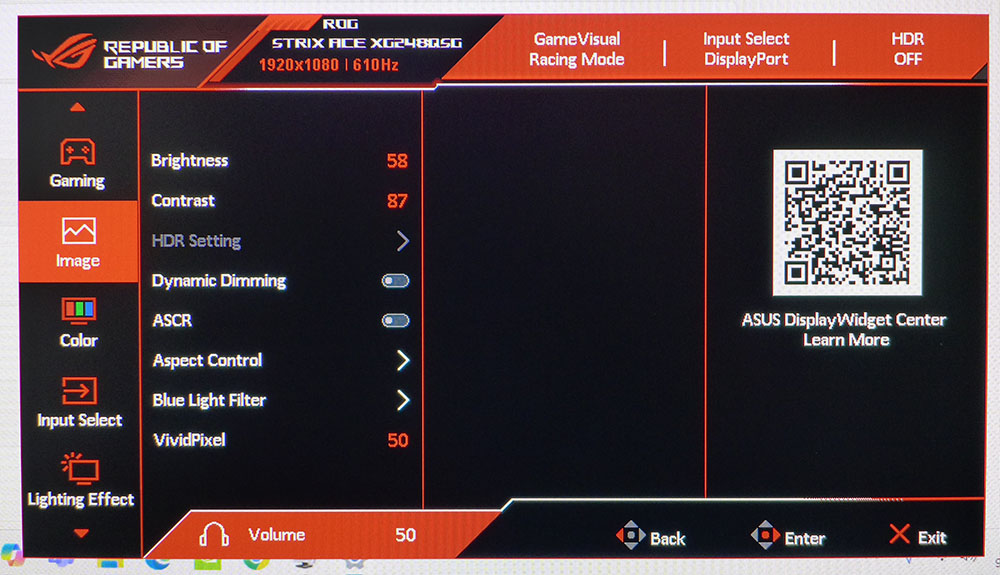
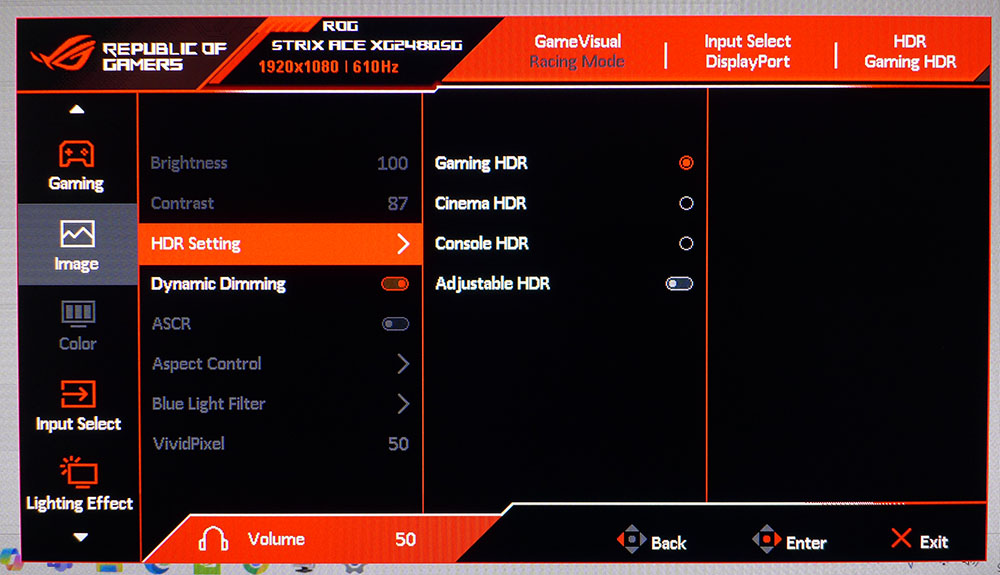
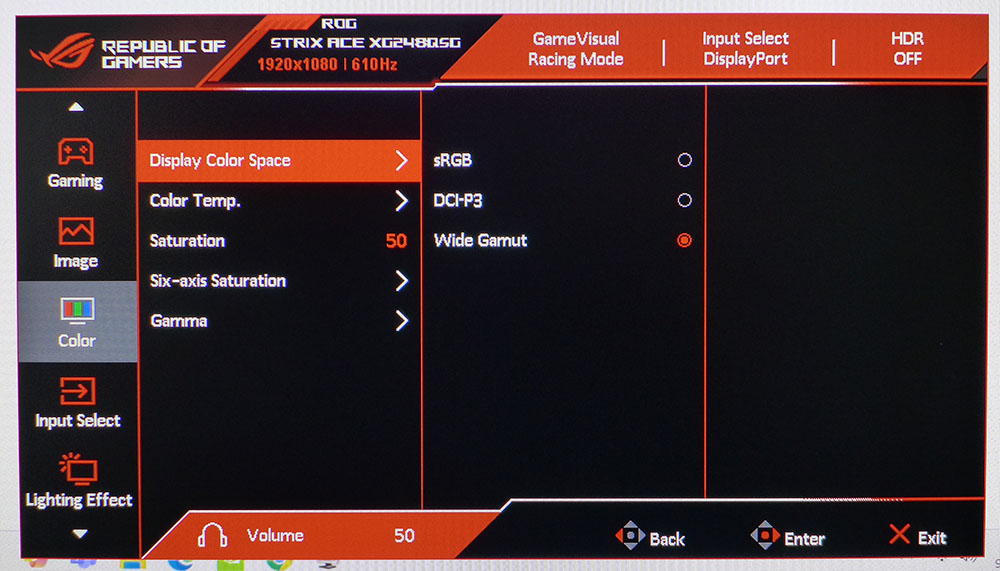
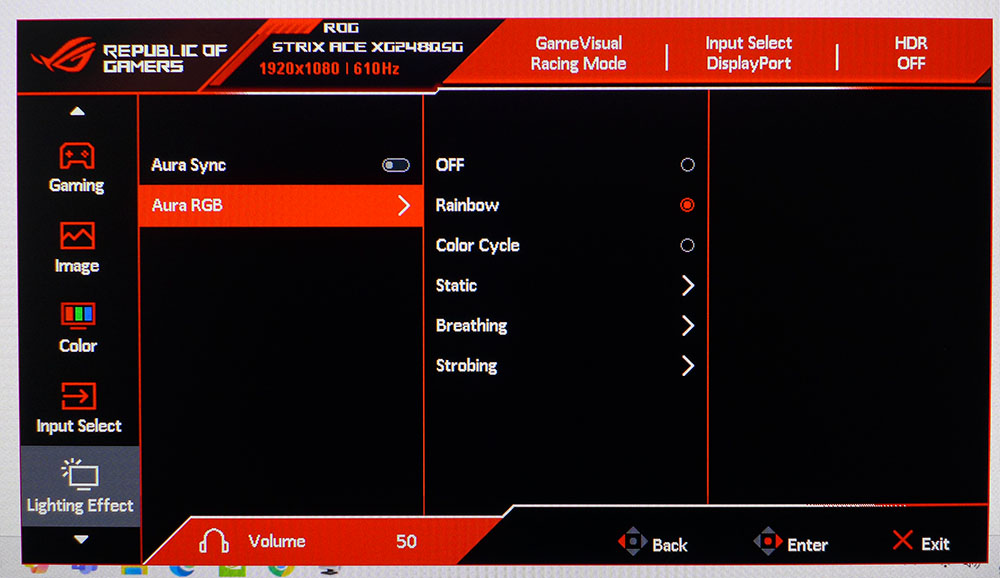
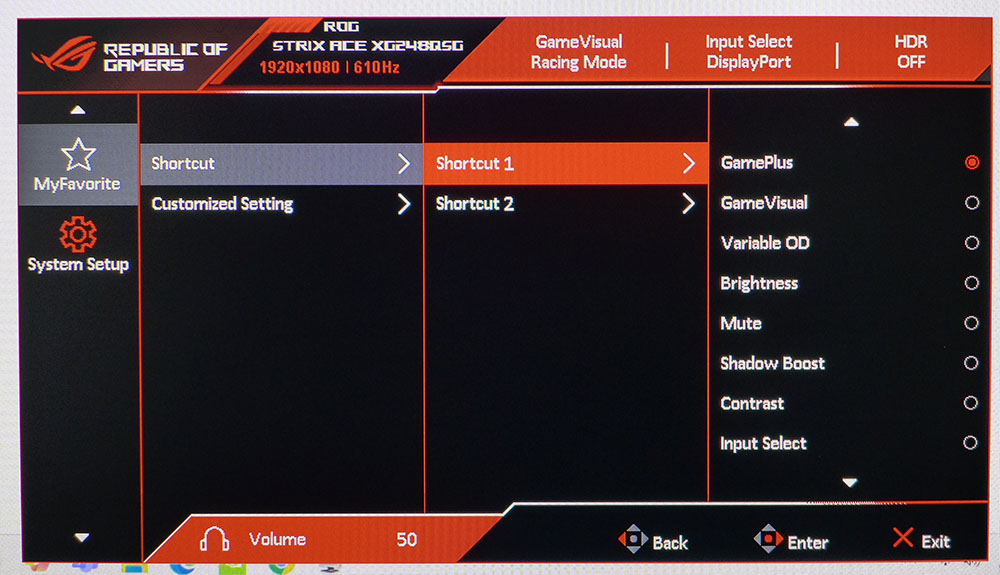
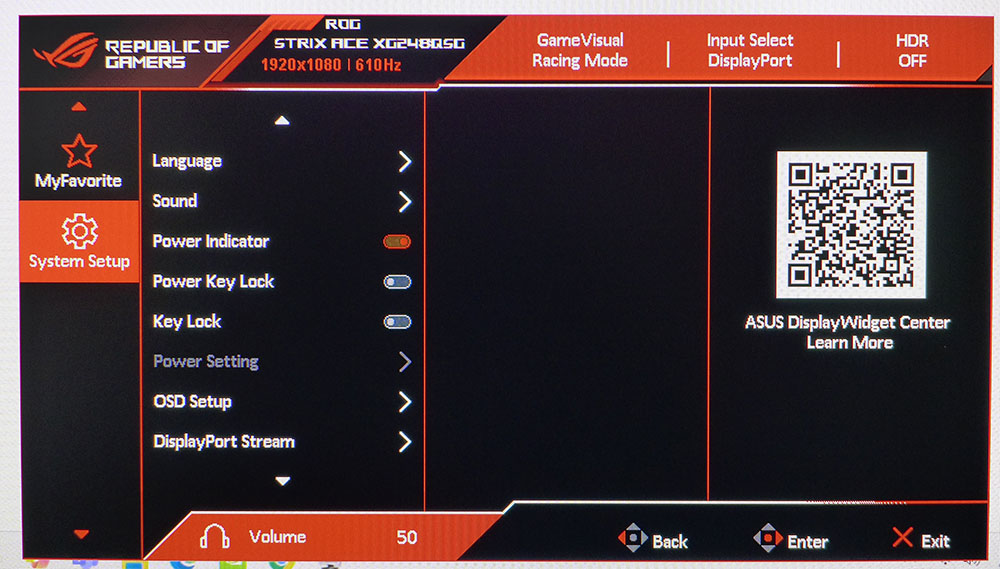
The Gaming menu is where the XG248QSG’s prime features are found. To achieve the full 610 Hz, enable the overclocking toggle. When it’s off, you still get 600 Hz. The overdrive has 20 possible settings, making it very precise. Then you come to ELMB, which is the best version of the tech I’ve seen yet. ELMB Sync works with Adaptive-Sync to prevent motion blur and frame tears. It’s very effective and it doesn’t have the phasing artifact common to this feature. If you want even more blur reduction, engage ELMB 2 with its five-level pulse width option. This is the smoothest way to play, but you might see the occasional frame tear if you look closely. It depends on the frame rate you’re able to achieve. Higher rates don’t need as much help, but if you run closer to 200 fps, ELMB is a great choice.
Gaming aids include aiming points in three shapes and two colors, plus a dynamic crosshair that changes color automatically with shifts in the background to remain in contrast. The sniper mode has three magnifications and two colors for the aiming dot. There are countdown timers and a stopwatch. Finally, alignment marks help you precisely line up multiple screens.
GameVisual is the XG248QSG’s picture modes and there are nine in total. Racing is the default and it’s close to the mark. Minor tweaks take it to even better accuracy. sRGB brings you that smaller gamut if you need it.
The Image menu has luminance controls along with Dynamic Dimming, which employs eight horizontal zones rather than the more typical 16 vertical ones. It’s part of the ELMB feature, but it’s also a good way to see deeper black levels. For HDR signals, you get three dedicated modes plus an adjust toggle that opens up brightness and contrast controls.
In the Color menu, there’s a full set of calibration options including three gamuts, fixed color temps, RGB sliders, color saturation and gamma presets. The XG248QSG is good enough to use without adjustment but a few tweaks of the RGB values bring a small but visible improvement. Here’s a tip: for sRGB color, keep it in Racing mode and choose that gamut from the Display Color Space menu. Then, you can calibrate if you want.
Aura is the XG248QSG’s LED lighting which is a large ROG logo in the back. It can show multiple colors and effects, and sync with onscreen action through Aura Sync and the DisplayWidget Center app. Two of the control keys can be programmed to the user’s wishes and you can save settings in two memory slots for later recall.
Asus ROG Strix XG248QSG Calibration Settings
Calibrating the XG248QSG isn’t strictly necessary, but I went for it with a few changes to the RGB sliders in the User color temp slot. It improved grayscale tracking visibly and made a small change to the gamut as well. I used the wide gamut for SDR content, but if you’d rather use sRGB, just choose it from the available color spaces. The 2.2 gamma preset tracked 2.2 almost perfectly. My recommended settings are below. In HDR mode, Gaming is the default and best choice with accurate EOTF and color tracking. The XG248QSG supports HDR10 signals.
Picture Mode | Racing |
Brightness 200 nits | 58 |
Brightness 120 nits | 25 |
Brightness 100 nits | 16 |
Brightness 80 nits | 8 (min. 62 nits) |
Contrast | 87 |
Gamma | 2.2 |
Color Temp User | Red 97, Green 95, Blue 100 |
Gaming and Hands-on
Like any fast monitor, you’ll need an equally fast video card to get the most from it. My test PC has a GeForce RTX 4090 and the fastest frame rate I saw in Doom Eternal was 525fps. It fluctuated quite a bit with the numbers dipping down into the 380-390 range at times. But the bottom line is that you’ll need something faster than an RTX 4090 to hit the XG248QSG’s full 610 Hz at FHD resolution and max detail with HDR engaged.
The best part is the new ELMB implementation, which really takes backlight strobing to another level. I have reviewed many monitors with this feature and with some of them, the phasing artifact is so bad that it is unusable. The XG248QSG is by far the best example. ELMB Sync works seamlessly with Adaptive-Sync, and there is no brightness penalty. Motion resolution is very high. ELMB 2 makes it pretty much flawless with no blur at all, but you will see the occasional frame tear. And brightness is reduced somewhat, depending on how much blur reduction you dial in. The most aggressive setting eliminates all blur, has no phasing, and cuts light by around 40%. Since there’s plenty of output headroom, there’s no downside. The XG248QSG is super flexible and has enough video processing options to please everyone.
Gameplay is super quick, even when compared against my average skills. Pro gamers will want to check out the XG248QSG for their toolkit. However, comparing it to a fast OLED like the XG27AQDPG, I prefer the look of the OLED, not just because it’s QHD but also for its better contrast and richer color. The XG248QSG is certainly colorful, more so than its LCD competitors, but it won’t match the saturation of a Quantum Dot OLED.
For daily use, it serves well with its 93ppi pixel density. If you’re spoiled by Ultra HD screens, it won’t seem sharp, but for tasks like writing or spreadsheets, it’s more than adequate. FHD isn’t the best choice for photo and graphics work, but at least the XG248QSG has the color to get those jobs done.
My physical interactions were all positive. The XG248QSG has excellent build quality and an intuitive menu system. I could change settings even more easily using Asus’ DisplayWidget Center app, which I downloaded for free. Between that, the joystick and the programmable control keys, it was a snap to make changes when needed.
Takeaway: The XG248QSG is a superb monitor and also incredibly fast. If you want to see 500 or 600fps, it’s the only game in town. Just make sure you have at least an RTX 4090 in your PC. I’d love to see what an RTX 5090 would look like. But in terms of gameplay experience and image quality, for the money, I’d go for a QHD OLED. Even an Ultra HD OLED will deliver comparable smoothness and the same low input lag at around 200fps for around the same cost as the XG248QSG.
MORE: Best Gaming Monitors
MORE: How We Test PC Monitors
MORE: How to Buy a PC Monitor
Current page: Features and Specifications
Next Page Response, Input Lag, Viewing Angles and Uniformity
Christian Eberle is a Contributing Editor for Tom's Hardware US. He's a veteran reviewer of A/V equipment, specializing in monitors. Christian began his obsession with tech when he built his first PC in 1991, a 286 running DOS 3.0 at a blazing 12MHz. In 2006, he undertook training from the Imaging Science Foundation in video calibration and testing and thus started a passion for precise imaging that persists to this day. He is also a professional musician with a degree from the New England Conservatory as a classical bassoonist which he used to good effect as a performer with the West Point Army Band from 1987 to 2013. He enjoys watching movies and listening to high-end audio in his custom-built home theater and can be seen riding trails near his home on a race-ready ICE VTX recumbent trike. Christian enjoys the endless summer in Florida where he lives with his wife and Chihuahua and plays with orchestras around the state.
